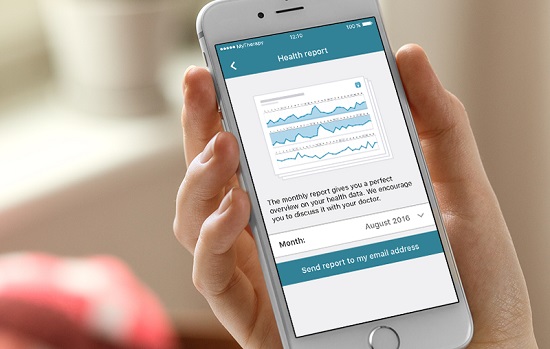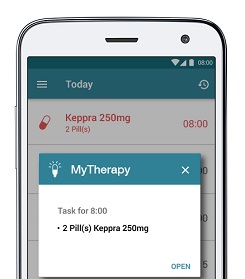Prevent Epileptic Seizures with a free Medication and Health Tracker App
If You’ve Been Diagnosed with Epilepsy, You’ll Need to Take Chronic Medication. Let MyTherapy Help You with Medication Management and Adherence

Epilepsy is a chronic condition characterized by recurrent, unprovoked seizures. Epileptic seizures may be caused by brain injury or genetics, but for the most part, the cause of epilepsy is unknown. Many people living with epilepsy experience more than one type of seizure and may have other symptoms of neurological problems too. If you have a single seizure, it doesn’t mean that you have epilepsy: you need to have at least two unprovoked seizures for a diagnosis. Having seizures can affect your safety, work, driving, relationships, and other important aspects of your life - so it is important that you manage your epilepsy effectively and prevent seizures. To do so, you will need to take medication (anti-epileptic drugs) regularly. You will therefore need to stick to a strict schedule so that you adhere to your medication and stay in control of your epilepsy. Medication can come with side-effects and sticking to a treatment plan isn’t always easy. You should therefore consider using medication tracker apps, like MyTherapy, to help you manage your medication, reduce medication side-effects, and prevent seizures.
If you have epilepsy, then MyTherapy can offer you the support you need when it comes to medication management. The app generates reminders, which you can use for both medication intake and upcoming doctors’ appointments. The reminders tell you when and how to take your medication and you can set different times on weekends if needs be. To upload your medication, you can use the app’s built-in barcode scanner to scan your medication packaging. Alternatively, you can search in the app’s database or upload your data manually. The alarm reminders can be set to silent or vibrate and you will also be notified to take your medication via a pop-up notification. MyTherapy therefore turns your treatment regimen into a simple list of daily tasks.
The app also features a digital health diary, which you can use to monitor medication side-effects or any symptoms you may be experiencing. This makes it easier to identify patterns of your epilepsy and possible triggers. Moreover, all data logged in the app can be shared with your doctor in the form of a monthly health report. This will allow him/ her to see how you are doing with the current treatment and adjust the medication for maximum efficacy and minimal side effects. And if you’d like some added support, you can invite family and friends on the app, who can help you with your medication adherence.
The team at MyTherapy takes user feedback seriously, so we are constantly developing the app to make sure it is tailored to your needs as best as possible. The app has a user-friendly design and can therefore be used by anyone, of any age.
A Neurological Disorder
Epilepsy is a disorder of the central nervous system in which brain activity becomes abnormal, causing seizures, unusual behavior, and loss of awareness. Seizures occur due to a disturbed balance of electrical activity in the brain. The brain cells, also known as neurons, communicate with each other through electrical impulses and chemical messengers. In seizures, there is a sudden burst of electrical activity that disrupts the normal functioning of the brain. There are various types of seizures and these depend on which part of the brain is affected. In some cases, a person remains aware of what is going on but experiences an odd feeling. Others may go into a “trance-like” state for a short period of time. In severe seizures, people lose consciousness and experience unusual jerking and shaking of the body.
Approximately 50 million people worldwide have epilepsy, making it one of the commonest disorders of the central nervous system.
Types of Seizures
Seziures can affect any process coordinated by your brain. Signs and symptoms of a seizure may include:
- Temporary confusion
- A staring spell
- Uncontrollable jerking movements of arms and legs
- Loss of consciousness or awareness
- Fear, anxiety
Different types of seizures will cause different types of symptoms, but in most cases, a person will have the same type of seizure each time and therefore similar symptoms with each episode. Generally, there are two types of epileptic seizures: focal (partial) seizures and generalized seizures.
Focal (partial) seizures affect only one area of the brain and therefore only one part of the body. These seizures fall into two categories, namely focal seizures without loss of consciousness and focal seizures with impaired awareness. In focal seizures without loss of consciousness, a person may experience changes in the way things look, smell, feel, taste, or sound. They can also cause involuntary jerking of a body part and tingling, dizziness, and flashing lights. In focal seizures with impaired awareness, a person may stare into space and not respond normally to the environment or perform repetitive movements (like chewing, walking in circles).
Generalized seizures affect both halves of the brain. There are six different types of generalized seizures, each with a different course and length of symptoms. Symptoms of generalized seizures may include:
- Convulsions (uncontrollable shaking of the body)
- Twitching movements
- Stiffening of the body
- Loss of consciousness
- Biting the tongue
- Loss of bladder control
- Loss of muscle control
- Falls
- Staring into space
- Repeated jerking muscle movements
For more information on what happens during a seizure, visit the Epilepsy Foundation's website.
There are other life-threatening complications of epilepsy, but these are uncommon. They include:
- Status epilepticus. This occurs when a person either experiences continuous seizure activity for more than five minutes or has recurrent seizures without regaining consciousness in between them.
- Sudden unexpected death in epilepsy (SUDEP). People whose seizures aren’t controlled by medication are at greater risk of SUDEP.
Diagnosis
If your doctor suspects that you have epilepsy, he/she will ask several questions based on your symptoms and medical history. Your doctor will also conduct various tests. These tests can rule out other conditions that may cause the seizures and identify which type of epileptic seizure you are experiencing. The most important tests used to diagnose epilepsy include an electroencephalogram (EEG) and a magnetic resonance imaging scan (MRI). EEG tests measure electrical activity in the brain and thereby detect unusual brain activity. MRI scans use magnetic fields and radio waves to produce images of the inside of the body, which can help detect where the abnormal brain activity takes place.
Typically No Clearly Identifiable Cause
In some cases – especially in late-life onset - it is possible to identify the causes of epilepsy. This is called symptomatic (or secondary) epilepsy. These cases are associated with brain damage, which may have occurred through having a stroke, a brain infection (e.g. meningitis), brain tumors, a severe head injury, dementia, or birth complications that deprive the child of oxygen. However, epilepsy has no identifiable cause in about half of the people with the condition. This is called idiopathic (or primary) epilepsy. Various researchers suggest that idiopathic epilepsy could be due to small genetic changes in the brain, but no definite link has been established between particular genes and the onset of epilepsy. Regardless of whether the cause of epilepsy is known, there are various triggers that can cause a seizure. These include stress, lack of sleep, alcohol or drug consumption, flashing lights, or the onset of menstruation in women. However, for many people, seizures occur without any obvious reason.
Taking AEDs to Control Seizures
After a specific diagnosis for the type of epilepsy has been made, it is possible to control the condition with medication. About 70% of patients are able to control the seizures by taking anti-epileptic drugs (AEDs). These work by altering the levels of chemical messengers in the brain that are responsible for conducting electrical impulses. The type of AED that is prescribed depends on various factors, such as the type of seizure you are experiencing, your age, other medications you may be taking, and any possible side-effects. Common AEDs include levetiracetam (Keppra), lacosamide (Vimpat), sodium valproate, carbamazepine, lamotrigine, oxcarbazepine, ethosuximide, and topiramate.
In some cases, brain surgery may be considered to remove the area of the brain where epileptic seizures are triggered. However, surgery only takes place if it does not cause any damage or disability. Alternative treatment methods include vagus nerve stimulation or adhering to a special type of diet called a ketogenic diet.
Manage Your AEDs with MyTherapy
Although it may sound simple, adhering to medication can turn into a daily challenge. However, if you have epilepsy, taking and strictly adhering to your AEDs is important to prevent seizures and lead an active and normal life. MyTherapy’s personalized medication reminders will turn medication adherence into a simple everyday to-do task, making it easier for you to control your condition. Furthermore, the health diary makes it possible for you to track your symptoms, side-effects, triggers, and any other health-related information such as sleep, diet, menstruation, and exercise. This makes it easier for you and your doctor to follow the course of the disorder and adjust your treatment plan to meet your specific needs. These features make MyTherapy a valuable companion when it comes to managing your epilepsy and leading an active and symptom-free life.


